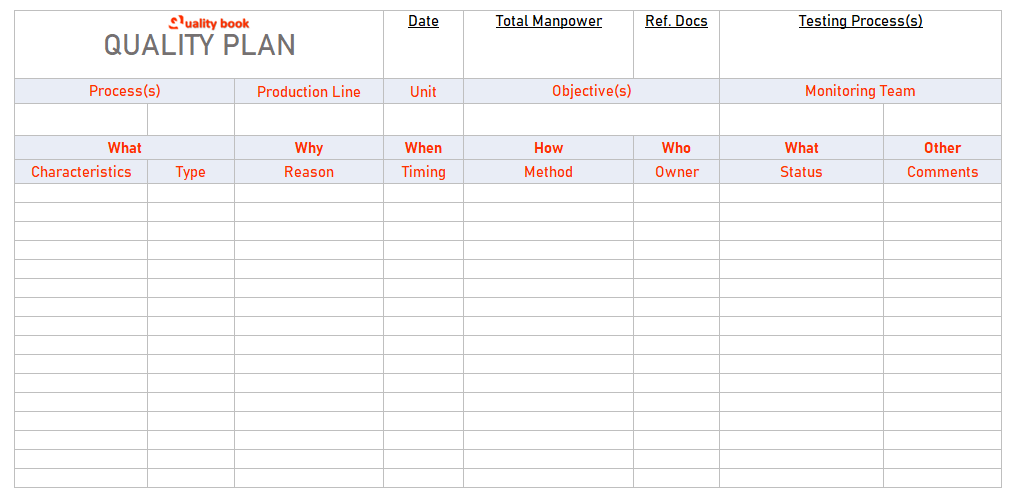Quality plan – a systematic, documented form of ensuring quality standards, quality practices, resources, specifications, and procedures are sequenced. This document describes the activities related to a particular product, service, project, or contract. Perhaps the basic objective of this process is to meet the client’s requirements by keeping the list of required independent reviews and quality goals in focus.
There are many reasons for creating and implementing a quality plan. You can use this quality plan when you set quality goals. Quality planning may have the following reasons for its goals:
- Identifying and directing customer needs
- Providing insight on the effectiveness of the organization’s quality management system
- Verifying your own external and internal standards and procedures
- Planning for production listing deliverables and defining quality standards for the deliverables
- Establishing quality standards for deliverables
- Compromise your clients with the set target.
- Provides objective evidence.
- Finding training needs of employees
- To develop excellent traceability i.e., the ability to trace any object, or problem.
In fact, quality plans are pre-written so that they meet all the requirements and expectations of the customers and the product. It is a method for measuring the achievement of quality objectives and other actions required to meet the objectives.
Quality plan sample template

What should be included in the quality plan?
- When you are preparing a quality plan, it should focus on the goals – the objective, a plan that underpins – should include product specifications, usage, cycle times, materials, and costs, etc.
- Try to include all stages of a process or production process.
- When you create quality plans, you have many production processes, activities, materials, manpower, and other processes to coordinate.
- Quality Process Measurement – A way to measure the value of a quality document.
- Standards – What are the practices and procedures that need to be in place?
- When you consolidate so many processes and other things, it is impossible for one or two employees to handle everything. Hence distribution of responsibilities is essential.
- Change/Revision Documentation Process – Gives you a way to track changes to the project or process.
- Required testing of processes and products, which occurs at each stage and even after the product is completed, so it is very important to ensure that the duration, people, and place of testing are fixed.
In general, a quality plan focuses on its objectives, reinforces, and drives further processes. A quality plan reinforces the allocation of responsibilities, authority, and resources – for all the different phases of the process.
How to implement a quality plan in manufacturing?
Implementation of a quality plan in the manufacturing unit is actually very important for improvement in the quality of products. This is a critical step that helps to ensure that the products are being meet the expected level of quality. Here as below some general steps that may help you to implement a quality plan in manufacturing:
Quality Objectives
Initially we have to identify the quality objectives. What are the quality objectives of the manufacturing processes through expecting to meet the standards, specifications as per requirements. We also have to ensure a quality plan will which standards, and product specifications to meet maximum requirements of customers.
Deployment of a quality plan
The quality plan is very important for achieving the quality objectives. Hence, we have to ensure that the quality plan should outline the key strategies and procedures, and well should include the required resources list. Make sure that, plan has clear guidelines for each stage of manufacturing – it may include from Raw Materials to Finished Products.
Training to employees
This step is very important to successful implementation of a quality plan in manufacturing processes. Usually, the training program is required to be held after the entire process is complete to develop a quality plan. The training can be associated with quality assurance & quality control. Hence, the training must include points such as identifying defects, perform quality checking, reporting quality issues etc.
Implement quality control measures.
This is time to implement quality control measures at each stage of the manufacturing process. It may help to ensure that the product meets the expected level of quality. These quality control measures can be – Inspections, Sample testing, and audits.
Monitor and measure results.
At the previous step, we had discussed about deployment of the quality measures at the various processes. Now, this is time to monitor the results of the quality control measures. This may help to ensure that these control measures are effective in meeting the quality objectives. Usually this includes collecting data, analyzing the results, and making any necessary adjustments to the quality plan.
Continuous improvement
Here we have the final step to the implementation of a Planning in the manufacturing processes. Continuous improvement is necessary to maintain the quality of the product, as well as understanding changing customers’ requirements. For perfect Continuous improvement we can get feedback from customers, employees, as well third parties’ suggestions for improve product quality.
Keep in mind, when you are going to implement of the planning in the manufacturing, there will be steps required to effectively implement is Planning, Implementation, monitoring, control, and improvement.